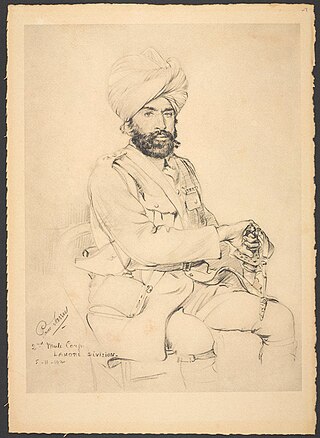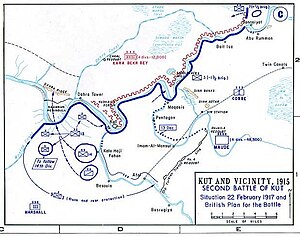The 10th Indian Division was an infantry division of the British Indian Army during World War I. It was formed in Egypt in December 1914 with three infantry brigades of Indian Expeditionary Force F. After taking part in the Actions on the Suez Canal, the division was dispersed as its brigades were posted away.

The Indian Army, also called the British Indian Army, was involved in World War I as part of the British Empire. Almost 1.5 million Indian troops served overseas, of whom 62,000 died and another 67,000 were wounded. In total at least 74,187 Indian soldiers died during the war.

The 7th (Meerut) Division was an infantry division of the Indian Army and before 1895, the Bengal Army, that saw active service during World War I.

The 3rd (Lahore) Division was an infantry division of the Indian Army and before 1895, the Bengal Army, first organised in 1852. It saw service during World War I as part of the Indian Corps in France before being moved to the Middle East where it fought against troops of the Ottoman Empire.
The 2nd Indian Cavalry Division was a division of the British Indian Army formed at the outbreak of World War I. It served on the Western Front, being renamed as 5th Cavalry Division on 26 November 1916. In March 1918, the 5th Cavalry Division was broken up. The British and Canadian units remained in France and the Indian elements were sent to Egypt to help constitute 2nd Mounted Division.
The 11th Indian Cavalry Brigade was a cavalry brigade of the British Indian Army that saw active service in the Indian Army during the First World War. It took part in the Mesopotamian campaign and was broken up soon after the end of the war.
The Meerut Cavalry Brigade was a cavalry brigade of the British Indian Army formed in 1904 as a result of the Kitchener Reforms. It was mobilized as 7th (Meerut) Cavalry Brigade at the outbreak of the First World War and departed for the Western Front where it served as part of the 2nd Indian Cavalry Division.
The Cavalry Division was formed in 1916 during First World War by units of the British Army and the British Indian Army stationed in India for service in Mesopotamia in the Mesopotamia Campaign. The Division was broken up in 1918, but its brigades then served independently.

The I Indian Corps was an army corps of the British Indian Army in the World War I. It was formed at the outbreak of war under the title Indian Corps from troops sent to the Western Front. The British Indian Army did not have a pre-war corps structure, and it held this title until further corps were created. It was withdrawn from the Western Front in December 1915 and reconstituted as I Indian Corps in Mesopotamia until the end of the war.
The 16th Indian Division was an infantry division of the Indian Army during the First World War. It was formed in December 1916, during the First World War. It was the only war formed division of the British Indian Army that was not sent overseas, instead it was sent to guard the North West Frontier. The division took over the responsibilities of the 3rd Lahore Divisional Area when it was disbanded in May 1917.
Indian Army during World War I order of battle
The 11th Gurkha Rifles was a Gurkha regiment of the British Indian Army. It was formed in Mesopotamia and Palestine in May 1918, saw active service in the First World War and the Third Anglo-Afghan War, and was disbanded in April 1922.
The 5th (Mhow) Cavalry Brigade was a cavalry brigade of the British Indian Army that saw active service in the Indian Army during the First World War. Formed in November 1914, it served on the Western Front as part of the 2nd and 1st Indian Cavalry Divisions until it was broken up in March 1918.
The Garhwal Brigade was an infantry brigade of the British Indian Army formed in 1902 as a result of the Kitchener Reforms. It was mobilized as 20th (Garhwal) Brigade at the outbreak of the First World War as part of the 7th (Meerut) Division and departed for France. It served on the Western Front until November 1915. It then moved to Egypt where it joined the 10th Indian Division, by now designated as 20th Indian Brigade. It left the division in March 1916 and thereafter served as an independent brigade in the Sinai and Palestine Campaign. It was broken up in 1920.
II Indian Brigade, Royal Horse Artillery was a brigade of the Royal Horse Artillery formed at the outbreak of World War I. It served with the 2nd Indian Cavalry Division on the Western Front. It was redesignated XVII Brigade, RHA in February 1917 and XVII Army Brigade, RHA just before being disbanded in April 1918.
The 12th Indian Brigade was an infantry brigade of the British Indian Army that saw active service in the First World War. It served in the Mesopotamian Campaign on the Euphrates Front throughout its existence.
The 35th Indian Brigade was an infantry brigade of the British Indian Army that saw active service with the Indian Army during the First World War. It took part in the Mesopotamian campaign and was disbanded shortly after the end of the war. It was not reformed for the Second World War.
The 28th Indian Brigade was an infantry brigade of the British Indian Army that saw active service with the Indian Army during the First World War. Formed in October 1914, it defended the Suez Canal in early 1915, ended the Ottoman threat to Aden in July 1915, took part in the Mesopotamian Campaign in 1916 and 1917, before finishing the war in the Sinai and Palestine Campaign. It remained in Palestine until it was broken up in 1920.
The 4th (Meerut) Cavalry Brigade was a cavalry brigade of the British Indian Army that formed part of the Indian Army during the First World War. It was formed as 14th (Meerut) Cavalry Brigade in November 1914 to replace the original Meerut Cavalry Brigade that had been mobilized as the 7th (Meerut) Cavalry Brigade for service on the Western Front. It remained in India throughout the war, before taking part in the Third Anglo-Afghan War in 1919.
The 4th (Secunderabad) Cavalry Brigade was a cavalry brigade of the British Indian Army that formed part of the Indian Army during the First World War. It was formed as Secunderabad Cavalry Brigade in February 1915 to replace the original brigade that had been mobilized as the 9th (Secunderabad) Cavalry Brigade for service on the Western Front. It remained in India throughout the war.





